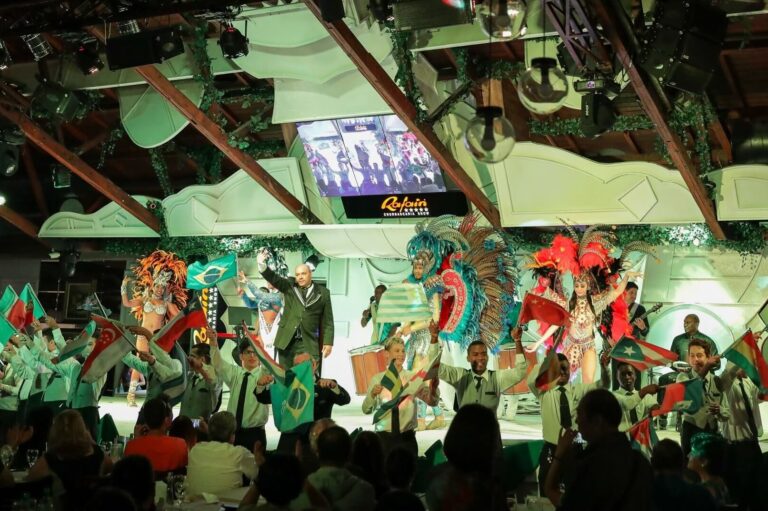Gastronomy is taking shape and gaining strength within the tourism industry, and both sectors are seeking to develop a more compelling culinary offering. Many times, the role of gastronomy is to attract customers to a particular place and then complement this offering with other tourism services.
Many places in our country have become gastronomic hubs around which various proposals have been added to welcome tourists on weekends or holidays. Others have specialized in offering unique local dishes, making this result an interesting culinary offering for the tourist eager to try different flavors on each of their trips.
Iguazu is no exception to this trend. Here, I will try to specify what you can eat and where it is best to enjoy the best of local gastronomy while enjoying the marvelous Iguazu Falls.
2 Day Trip to Iguazu Falls From Buenos Aires
Experience the wonder of Iguazu Falls on a private 2 day tour from Buenos Aires. Easily reserve accommodations and optional activities. Book now!
- Traditional
From Price: USD190
WHAT TO EAT IN IGUAZU FALLS: THE LOCAL DISHES
In Iguazu, you can enjoy a variety of delicious dishes that showcase the flavors of the region. Some popular options include:
Surubí and Pacú
Surubí is a river fish that`s extremely popular on restaurant menus in the town and hotels. It`s a type of South American catfish that can be caught in the Iguazu or Parana rivers. It can grow to over one meter in length, up to 50kg in weight! And its high quality of flesh is revered in the region. Although it can be expensive, this should definitely be tried by fans of fish dishes. Ensure with the restaurant you choose that the fish has been caught fresh.
It’s a popular fish in regional cuisines, especially in countries like Argentina, Paraguay, and Brazil. Here are a few dishes that feature surubí:
Surubí a la Parrilla (Grilled Surubí): Surubí is often grilled over an open flame or on a barbecue (parrilla) to enhance its natural flavor. It’s usually seasoned with salt, pepper, and sometimes herbs or lemon juice for added taste.
Surubí en Salsa (Surubí in Sauce): Surubí fillets or steaks are cooked in a flavorful sauce made from ingredients like tomatoes, onions, garlic, bell peppers, and various herbs and spices. The sauce is simmered until it thickens and coats the fish, creating a delicious and savory dish.
Surubí al Horno (Baked Surubí): Surubí can be baked in the oven with a variety of ingredients. It’s often prepared with sliced vegetables such as potatoes, carrots, and onions, along with herbs, olive oil, and sometimes white wine. The fish is baked until tender and served hot.
Surubí Empanizado (Breaded Surubí): Surubí fillets are coated in seasoned breadcrumbs or flour, then pan-fried or deep-fried until crispy and golden brown. This method adds a crunchy texture to the fish while preserving its moist interior.
Surubí a la Milanesa (Surubí Milanese): Similar to the breaded surubí, this dish involves coating surubí fillets with breadcrumbs, but it’s then topped with tomato sauce and melted cheese before being baked or broiled. It’s a variation of the classic Italian veal Milanese.
Afternoon Iguazu Falls Tour with Sunset & Drinks – Brazil Side
Enhance your visit to Iguaçu National Park in Brazil and experience a breathtaking sunset at Iguazu Falls with a delightful drink in hand.
- Nature
- Traditional
From Price: USD125
Surubí Ceviche: Surubí can also be used to make ceviche, a popular dish in South America. The fish is marinated in citrus juices such as lime or lemon, mixed with onions, peppers, cilantro, and other seasonings. The acidity of the marinade “cooks” the fish, resulting in a refreshing and tangy dish.
These are just a few examples of how surubí can be prepared in various culinary styles. Its firm texture and mild flavor make it versatile for cooking, and it’s often enjoyed as a delicacy in the regions where it’s found.
Another great fish to taste is the Pacú, similar to the Piranha. It`s another type of river fish that is an even more adventurous option than the Surubi, though it is not so easily found on the menu.

Mbeyú
It`s a traditional food of the Guaraní Indians, a fried dough patty of mandioca with milk or water, salt and cheese. It’s a simple yet flavorful dish that is popular throughout Paraguay and parts of the surrounding regions.
Do you want to prepare the Mbeyú? Follow the instructions below and try it!
Ingredients: The main ingredients of mbeyu include cassava flour (known as yuca harina or almidón de mandioca), cheese (often Paraguayan cheese like queso Paraguay or queso fresco), water, and salt. Sometimes, ingredients like eggs or milk are added to enhance the flavor and texture.
Preparation: To prepare mbeyu, cassava flour is mixed with water, cheese, and salt to form a thick, dough-like consistency. This mixture is then spread evenly in a pan and cooked until it forms a golden crust on the outside while remaining soft and slightly gooey on the inside.
Variations: While the basic recipe for mbeyu remains relatively consistent, there are variations in the ingredients and preparation method based on personal preferences and regional differences. Some recipes may include additional ingredients like eggs, milk, butter, or herbs and spices to enhance the flavor.
Serving: Mbeyu is typically served as a side dish or snack and is enjoyed warm. It can be served plain or accompanied by various toppings or sauces, such as salsa criolla (a tomato-onion relish) or chimichurri (a parsley-garlic sauce).
Cultural Significance: Mbeyu is a dish deeply rooted in Paraguayan culinary tradition and culture. It’s often enjoyed during gatherings, celebrations, and family meals, and is cherished for its simplicity and comforting flavor.
Overall, mbeyu is a delicious and versatile dish that showcases the rich culinary heritage of Paraguay. Its unique texture and taste make it a beloved favorite among locals and visitors alike.
Private Day Tour to Iguazu Falls from Argentina or Brazil
Experience Iguazu Falls from Buenos Aires, Sao Paulo, or Rio de Janeiro with our Day Tour.
- Traditional
From Price: USD230
The chipa
Also called paraguayan cake, the typical chipá is made with starch, milk, cheese, lard, eggs and salt. This amazing snack holds cultural significance in both countries: Argentina and Paraguay. Here’s more information about chipa:
Ingredients: Chipa is typically made from manioc starch (also known as cassava or yuca flour), cheese (commonly a type known as queso Paraguay), eggs, milk, salt, and sometimes butter or lard. The dough is formed into various shapes before baking.
Preparation: The preparation of chipa involves mixing the manioc starch with grated cheese, eggs, milk, and salt to form a dough. The dough is kneaded until smooth and then shaped into small balls, rings, or horseshoe shapes, depending on regional preferences. These shapes are then baked until golden brown.
Varieties: There are different types of chipa based on variations in ingredients and shapes. Some common varieties include chipa almidón, made with only manioc starch and cheese; chipa caburé, which includes additional ingredients like lard or butter; and chipa guazú, a type of chipa that resembles a cake and is made with fresh corn kernels.
Cultural Significance: Chipa is deeply rooted in Paraguayan and northeastern Argentine culture and is often enjoyed as a snack or breakfast item. It is commonly consumed with tereré, a traditional Paraguayan cold beverage similar to mate but served with cold water.
Half Day Tour to Iguazu Falls (Brazil Side) & Dinner with Samba Show in Rafain Churrascaria
A day full of activities, visiting Iguazu Falls Brazilian Side and then, enjoying a wonderful Dinner Show in Rafain Churrascaria
- Cultural
- Traditional
From Price: USD150
Occasions: Chipa is commonly prepared and enjoyed during religious celebrations, festivals, and other special occasions. It is also a staple snack sold by street vendors and bakeries throughout Paraguay and northeastern Argentina.
Nutritional Value: Chipa is a rich source of carbohydrates due to its main ingredient, manioc starch. The addition of cheese provides protein and fat, making it a filling and satisfying snack.
Regional Variations: While chipa is most commonly associated with Paraguay and northeastern Argentina, variations of this snack can also be found in neighboring countries like Brazil and Bolivia, where it may be known by different names and prepared with slight differences in ingredients.
Overall, chipa is not just a snack but also a symbol of cultural identity and tradition in Paraguay and northeastern Argentina, where it continues to be cherished and enjoyed by people of all age

The Paraguayan Soup
The famous paraguayan soup doesn’t actually is a typical soup. It`s a type of oven baked bread, made of white corn flour, onions and cheese. Very tasty!
The Tererè
The area is hot, and a good icy drink, done with “yerba mate” is very usual in Iguazu Falls and surrounding areas.
This traditional South American cold beverage that originated in Paraguay and is also popular in northeastern Argentina, particularly in provinces like Corrientes and Misiones. Here are some details about tereré:
Ingredients: Tereré is made using yerba mate (Ilex paraguariensis), which is a type of holly plant native to South America. The yerba mate leaves are dried, ground, and often mixed with additional herbs or flavors like mint, citrus peels, or lemongrass. Cold water is then added to the yerba mate to create the beverage.
Preparation: To prepare tereré, a hollowed-out gourd called a guampa or a special cup called a guampa is filled with yerba mate leaves. Cold water is then poured over the leaves, and the beverage is sipped through a metal or wooden straw called a bombilla. Unlike traditional hot mate, which is prepared with hot water, tereré is enjoyed cold, often with ice added to the drink.
Social and Cultural Significance: Tereré is more than just a beverage; it’s a cultural symbol and a social activity in Paraguay and northeastern Argentina. Sharing tereré is a common social practice among family members, friends, and communities. It is often enjoyed during gatherings, outdoor activities, and informal meetings, fostering camaraderie and conversation among participants.
Health Benefits: Yerba mate, the main ingredient in tereré, contains caffeine, theobromine, and other compounds that are believed to provide various health benefits, including increased energy, improved mental focus, and antioxidant properties. Some studies also suggest that yerba mate may have positive effects on cardiovascular health and metabolism.
Regional Variations: While the basic preparation of tereré involves yerba mate and cold water, there are regional variations in flavorings and additives. In some areas, tereré may be prepared with fruit juices, herbs, or even carbonated beverages for added flavor and refreshment.
Lifestyle and Tradition: Tereré is not just a beverage but a way of life for many people in Paraguay and northeastern Argentina. It is deeply ingrained in the cultural fabric of these regions, representing shared moments of relaxation, conversation, and connection with nature.
3 Day Tour to Iguazu Falls From Buenos Aires
Experience the awe of Iguazu Falls on a 3-day tour from Buenos Aires. Book now for an unforgettable adventure!
- Traditional
From Price: USD290
OTHER TIPICAL ARGENTINIAN DISHES IN IGUAZU FALLS
Of course, another typical dishes in Argentina are also popular in Iguazu area, like the Churrasco or beef, the typical empanadas, and the famous asado
WHERE TO EATH TYPICAL DISHES IN IGUAZU FALLS?
in Iguazu Falls, you can find various places to enjoy typical dishes of the region. Here are some recommendations for where to eat typical dishes in the area:There are many restaurants in Puerto Iguazú, the town nearest to the Argentine side of the falls, where you can taste typical Argentine cuisine. Look for restaurants that specialize in regional dishes such as empanadas, asado (barbecue), and milanesa (breaded and fried meat).
In the vicinity of tourist attractions like Iguazu Falls, you’ll often find market stalls or food kiosks offering local delicacies. These stalls may serve freshly prepared snacks like chipa (cheese bread), choripan (chorizo sandwich), and other traditional treats.
Morning Iguazu Falls Tour with Sunrise & Breakfast – Brazil Side
A wonderful full day trip to visit the Iguazu Falls Brazilian Side, starting early in the morning with early entrance to see the sunrise!
- Adventure
- Nature
- Romance
From Price: USD125
Explore local cafés and bakeries in Puerto Iguazú where you can sample traditional pastries and baked goods. Look for specialties like pastelitos (pastry filled with sweet or savory fillings), medialunas (croissants), and tortas fritas (fried pastries). Seek out restaurants or eateries that specifically highlight regional specialties from Misiones province, where Iguazu Falls is located. These establishments may feature dishes made with locally sourced ingredients such as freshwater fish like surubí, pacú, and dorado, as well as indigenous-inspired dishes like mbeyú and chipa guazú.
Consider joining a food tour or culinary excursion in Puerto Iguazú, where local guides can lead you to hidden gems and authentic eateries that serve up the best of regional cuisine. These tours provide insight into the culinary traditions, ingredients, and flavors of the area. Our sales team will prepare a good tour based in the gastronomy tasting of the different dishes you can find in the area.
BOOK A GASTRONOMY TOUR IN IGUAZU FALLS
Our sales team can put together a program for you, including tasting typical dishes. But if you want to have an idea of what can be offered, review the itinerary by clicking on the image below.









